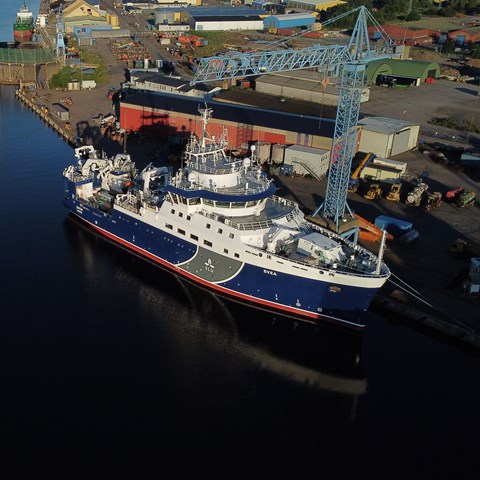Contact
Lasse Thorell, Ship Manager
Ship Management Unit, SLU
lasse.thorell@slu.se, +46(0)18-67 15 07, +46(0)70-557 15 07
Björn Lindell, Coordinator
Ship Management Unit, SLU
björn.lindell@slu.se, +46 (0)18 67 15 46, +46 (0)73-086 98 86

After a long-planned month at the shipyard in Falkenberg, R/V Svea is now out on an expedition again; newly painted, newly serviced and upgraded with new scientific equipment and an improved IT environment.
"It's been five years since Svea was delivered to us at the shipyard in Vigo, Spain, and now we've celebrated her five-year anniversary with a major facelift," says Lasse Thorell, head of SLU's ship unit.
All large vessels must be docked regularly, for inspection and for more qualified maintenance and repairs. For Svea's part, this visit to the shipyard entailed, among other things, dry-setting for blasting and repainting of the hull and the installation of a new, more robust exhaust system. In connection with the docking, the survey was also carried out that extends Svea's ship classification from the international classification organization DNV for another five years.
Upgraded IT environment
To meet the growing needs for large amounts of data, lightning-fast transfer and high security requirements, Svea's IT infrastructure has been upgraded.
"At SLU, we are used to building, managing and operating research systems for demanding environments, and now we have an IT environment that is even better, more stable, faster and more flexible. A modern IT system is absolutely central on a research vessel to ensure efficient data collection, communication and collaboration," says Björn Lindell, ship coordinator at SLU's Ship Unit.
A vital part of Svea's IT environment is the connection to Starlink Maritime, a high-speed internet that enables seamless transfer of large amounts of data in real time.
Researcher-driven innovation and development
Already this spring, Svea's scientific equipment was supplemented with another multibeam sonar, which makes it possible to quickly map large areas and create high-resolution, three-dimensional maps of the seabed. During the latest docking, a sub-bottom profiler has now also been installed, a penetrating sonar that can see even deeper; and map sediments and structures below the seabed surface.
"Owning and operating a research vessel involves continuous improvement work. We will meet the needs of our customers today, but also equip Svea for the future, and we do this best by involving researchers directly in the development process. We want to translate the visions of the research community into reality," says Björn Lindell.
Svea – part of Sweden's and Europe's research fleet
The five-year docking also means that Svea will now welcome the researchers who are looking for ship time in the infrastructure investments Swerve and Aquarius, newly serviced and fresh.
Swerve is a national initiative supported by the Swedish Research Council, through which researchers will be able to apply for ship time on Svea and five other Swedish research vessels. The first call will open in autumn 2024.
Aquarius is a similar infrastructure programme, but at European level, and funded through Horizon Europe, the EU's framework programme for research and innovation. SLU and R/V Svea are one of 44 European organisations that are part of this, with the aim of giving international research projects access to ship time and advanced equipment. Here, too, the first call will open in autumn 2024.
"The cost of renting a research vessel is often too high for individual researchers and research projects. By participating in these initiatives, we can create the conditions for more marine research," says Lasse Thorell.
Lasse Thorell, Ship Manager
Ship Management Unit, SLU
lasse.thorell@slu.se, +46(0)18-67 15 07, +46(0)70-557 15 07
Björn Lindell, Coordinator
Ship Management Unit, SLU
björn.lindell@slu.se, +46 (0)18 67 15 46, +46 (0)73-086 98 86